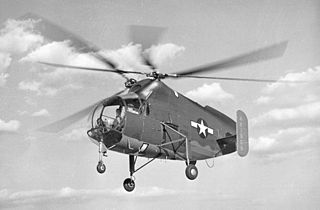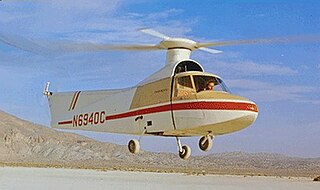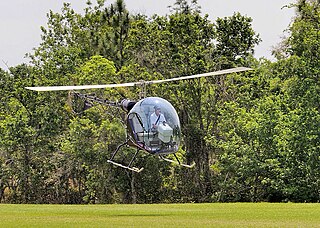
The Hughes XH-17 "Flying Crane" was the first helicopter project for the helicopter division of Hughes Aircraft Company. The XH-17, which had a two-bladed main rotor system with a diameter of 134 feet, still holds the world record for flying with the largest rotor system. It was capable of flying at a gross weight of more than 50,000 pounds (23,000 kg), but proved too inefficient and cumbersome to be mass-produced beyond the prototype unit.

The Brantly B-2 is an American two-seat light helicopter produced by the Brantly Helicopter Corporation.

The Cierva C.8 was an experimental autogyro built by Juan de la Cierva in England in 1926 in association with Avro. Like Cierva's earlier autogyros, the C.8s were based on existing fixed-wing aircraft fuselages – in this case, the Avro 552.

The Gyrodyne RON Rotorcycle was a tiny, single-seat helicopter designed under contract for the United States Navy. in the mid-1950s. It later was redesigned for a U.S. Marine Corps requirement for a small personal helicopter that would fulfill a number of roles, including observation, liaison, small unit tactical maneuvers, and which could be dropped to downed airmen behind enemy lines to facilitate their escape.

The Sikorsky S-52 is a utility helicopter developed by Sikorsky Aircraft in the late 1940s. It was used by the U.S. Navy, Marines, and Coast Guard. The S-52 was the first US helicopter with all-metal rotor blades. A two-seater, it was developed into the four-seat S-52-2. It was designated HO5S-1 by the U.S. Navy and Marine Corps; HO5S-1G by the Coast Guard; and YH-18A by the Army.

The Kellett XR-8 was a helicopter built in the United States during World War II. It was a two-seat machine intended to demonstrate the feasibility of a twin-rotor system, and while it accomplished this, it also demonstrated a number of problems that prevented further development of this particular design.

The Lockheed CL-475 is a two-seat, single-engine light helicopter developed by Lockheed to explore rigid rotor technology. The CL-475 has a three-bladed main rotor and a two-bladed tail rotor. Only one was built.

The Doblhoff/WNF 342 was the first helicopter to take off and land using tip jets to drive the rotor.

The Rotorcraft XR-11, known by the company as the X-2 Dragonfly, was an American two-seat lightweight helicopter built in the 1940s for evaluation by the United States Air Force by the Rotorcraft Corporation of Glendale, California.

The Canadian Home Rotors Safari is a kit helicopter, produced by CHR International of Marianna, Florida, and formerly produced by Safari Helicopter of Ear Falls, Ontario.
The Baumgärtl Heliofly III/57 and Baumgärtl Heliofly III/59 were 1940s experimental backpack helicopters designed and built by the Austrian-designer Paul Bäumgartl. Following on from his earlier experiments with strap-on autgyros the Heliofly III/57 was powered by two 8 hp (6 kW) Argus As 8 piston engines each driving a single-blade of the contra-rotating rotors.
The Masquito M80 was a Belgian two-seat ultralight helicopter designed and built by Masquito Aircraft.
The Airmaster H2-B1 is a British two-seat ultralight helicopter built by Airmaster Helicopters of Camberley, Surrey.

The PZL SM-4 Łątka was a prototype three-seat helicopter of the 1960s, developed by WSK PZL-Świdnik in Poland. Of largely conventional design and construction, a single prototype was built, but was not flown as a result of engine problems.
The VTOL Aircraft Phillicopter is a 1970s Australian light utility helicopter designed and built by VTOL Aircraft of Newcastle West, New South Wales.

The Matra-Cantinieau MC-101 was an early 1950s French experimental two seat helicopter of conventional tail rotor configuration but with its engine mounted close to the main rotor, above the seating.
The Vortech A/W 95 is an American helicopter that was designed by Adams-Wilson as the Adams-Wilson Choppy and now produced in an improved version by Vortech of Fallston, Maryland. The aircraft is supplied in the form of plans for amateur construction. Vortech also supplies rotor blades and other key parts for the design.

The Enstrom TH180 is a single piston-engined two-place training helicopter manufactured by Enstrom in the United States.
The Midwest Zodiac Talon-Turbine is an American helicopter that was designed and produced by Midwest Engineering & Design of Overland Park, Kansas. When it was available the aircraft was supplied in the form of plans for amateur construction, but the plans are no longer advertised for sale.
The Sikorsky S-50 was a smaller lighter version of the Sikorsky R-6 designed for the United States Army Air Corps as an observation helicopter with dual controls in 1943. The design emphasized minimal weight and was to be powered by a 150 hp (112 kW) Franklin 6ACV-298 engine turning a three blade main rotor constructed of metal and plywood covered by 2 layers of fabric. The tail rotor also had three blades made from laminated wood. Further weight savings of the design included the rejection of a conventional oleo strut tail wheel in favor of a tail skid on a pivot cushioned by three rubber doughnuts. One full scale wooden mock-up was built but no flying examples were ever produced.













